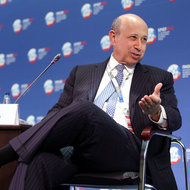After a year of mixed financial performance at Morgan Stanley, the firm’s chief executive, James P. Gorman, is expected to take a second annual pay cut.
Mr. Gorman’s compensation for last year is estimated to be slightly less than the $10.5 million he took home in 2011, according to a person briefed on the matter. His 2011 pay was down 25 percent from the previous year.
The total value of Mr. Gorman’s compensation package for 2012 is not yet known, but according to a regulatory filing on Thursday, the bank’s board awarded him stock options valued at $2.6 million, on top of his base salary of $800,000. He is expected to earn another $2.6 million in deferred cash, according to this person, who spoke on condition of anonymity because some of the compensation details are not yet public.
Morgan Stanley had to contend with challenges in 2012. On the one hand, its stock rose 26 percent to $19.12, and its fourth-quarter earnings were fairly strong, exceeding analysts’ expectations. On the other hand, it managed to produce a return on shareholder equity of only 5 percent for the year, compared to 10.7 percent at its rival Goldman Sachs. Simply to cover its debt expenses and other capital costs, Morgan Stanley needs to achieve a return on equity closer to 10 percent.
While the firm has made progress in building out its wealth management operation, its fixed-income department, which was badly bruised during the financial crisis, continues to struggle. These issues, according to the person briefed on the matter, played a role in the board’s decision to cut Mr. Gorman’s pay.
The stock options Mr. Gorman was awarded give him the right to buy Morgan Stanley shares in the future at a preset price. But the options will be worthless if the company’s shares fell below that price. In previous years, Mr. Gorman had been granted restricted stock units, which are stock grants tied to the price of the firm’s shares when they vest down the road.
The board decided to grant options rather than restricted stock in 2012 because Morgan Stanley failed to meet the performance criteria set out in a 2001 shareholder resolution that would have allowed it to qualify for full corporate tax deductibility. One reason it failed to meet the conditions was an accounting charge that created huge volatility in its earnings but did not reflect its underlying performance. As a result, the company reported a loss of $117 million for last year. Excluding that charge, its profit was roughly $3 billion.
Mr. Gorman was not the only Wall Street chief to see his pay fall. JPMorgan Chase announced last week that its board was cutting in half the 2012 pay of its chief executive, Jamie Dimon, to $11.5 million, after the bank suffered an embarrassing $6 billion trading loss last year on his watch.
In contrast, Goldman’s chief executive, Lloyd C. Blankfein, is on track to get a raise. Last week, he was granted restricted stock valued at $13.3 million for 2012, nearly double his stock award the previous year. That was on top of a base salary of $2 million. Goldman has not yet revealed the size of Mr. Blankfein’s cash bonus.
Other top executives at Morgan Stanley are also expected to see their pay drop somewhat, according to the person briefed on the matter. Gregory J. Fleming, who leads the firm’s wealth management division, was granted stock options valued at $2.4 million, as was Colm Kelleher, who runs institutional securities. Their total compensation packages are not known, but the person briefed on the matter said their pay would be down from the previous year.
Article source: http://dealbook.nytimes.com/2013/01/24/morgan-stanley-chief-to-take-pay-cut-for-a-second-year/?partner=rss&emc=rss


